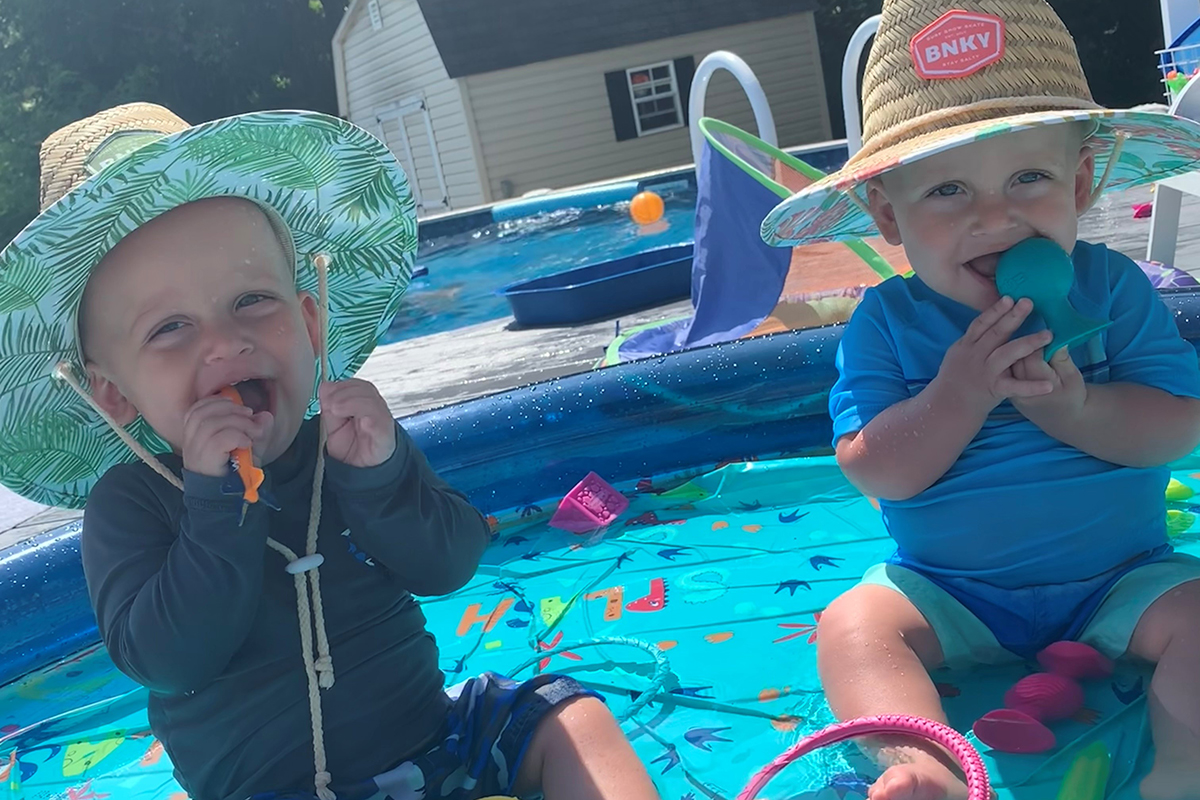-
Services
Featured Specialties
-
Locations
Location Type
-
Patients & Visitors
Published October 31, 2023

Ashley Western of Orange, CT was about 8 weeks along with her second pregnancy when the ultrasound technician encouraged her to FaceTime her husband. Ashley, an oncology nurse practitioner at Smilow Cancer Hospital, braced for something to be wrong with her baby.
The technician continued, there are two!
“Two what?” asked Ashley, whose family lineage does not include twins, as she got her husband on the phone. “We could see that the twins were monochorionic diamniotic,” said Ashley. “Meaning they share a placenta but have their own amniotic sacs. As a clinician it can be hard to make the mental switch to being a patient. I already knew I was high-risk and started projecting how this journey could play out medically.”
Ashley started visiting Yale Maternal Fetal Medicine for ultrasounds to track growth and look for abnormalities. She knew twin-to-twin transfusion syndrome (TTTS) was a possible but very rare occurrence with these types of twins.
TTTS, which occurs in around 6-15 percent of identical twins, is a condition in which the blood flows unequally between twins that share a placenta so that one twin is overworked, and one twin is undernourished. About 90 percent of twins diagnosed in the later stages of TTTS who don't receive treatment pass away before birth.
Around the 20-week scan, Baby A’s fluid was increasing while Baby B’s fluid was declining which prompted Ashley to have scans three times weekly. During this time she was followed by the Yale Medicine Maternal Fetal Medicine specialists, as part of the Yale New Haven Children’s Fetal Care Center, who have expertise in the management of complicated monochorionic diamniotic twins.
At first, Ashley was hesitant to call her clinical team after normal working hours when she had minor concerns. However, every time she called she was met with compassion. Each member of the team was up to speed on her care and encouraged her to continue being an informed and proactive participant in the care of her baby.
By the 26th week the twin-to-twin transfusion syndrome had progressed and it was time to take action.
“Fetoscopic laser surgery offers the best chance of correcting the vascular imbalance in twin-to-twin transfusion syndrome, ” said Katherine Kohari, MD, associate director, Fetal Care Center and assistant professor at Yale School of Medicine. During the procedure Dr. Kohari made a small incision in Ashley’s abdomen and placed a tiny metal probe equipped with a camera and a laser into the amniotic sac of one of the twins.
“Once we have a good picture of what we need to see, we use a laser to burn abnormal vascular connections and separate the placentas from each other, so the twins are no longer sharing blood flow,” said Dr. Kohari.
Only about 30 to 40 hospitals nationwide can perform fetoscopic laser surgery to treat twin-to-twin transfusion syndrome, Yale Medicine estimates. Since the procedure can cause premature labor, the clinical team waited until 26 weeks so they could deliver the babies if necessary. The Neonatal Intensive Care Unit (NICU) team, who provide specialized expertise in the care of critically ill newborns, was prepared to jump in at a moment’s notice.
“The procedure itself was not painful. However, one of the babies kept trying to grab the probe, so it took much longer than expected!” said Ashley who was able to go home the next day. “The magnesium drip I was on after the procedure was the hardest part to tolerate because of the nausea, and grogginess.”
A week after the procedure the disproportional fluid flipped to the other baby and eventually evened out to everyone’s relief. “The NICU team was with me every step of the way explaining what to expect should I deliver that week,” said Ashley.
Ashley was able to return to her regular OBGYN while the Fetal Care Center continued to monitor her. Ashley was induced at 34 weeks and on July 15, 2022 welcomed Crew and Bodie –4lbs 6 oz and 4 lbs 7oz respectively.
“Ashley’s primary OBGYN partnered with us on the birth,” said Dr. Kohari. “We were thrilled to make it to 34 weeks where the risk of long-term complications is greatly reduced.”
The babies had short stays in the NICU to help with breathing issues related to prematurity.
“It was hard not having them in the room, but I was more relieved that they were out, and in good hands,” said Ashley.
Ashley has since returned to work, but carries this experience with her – knowing how extra preparation, support and understanding make all the difference.